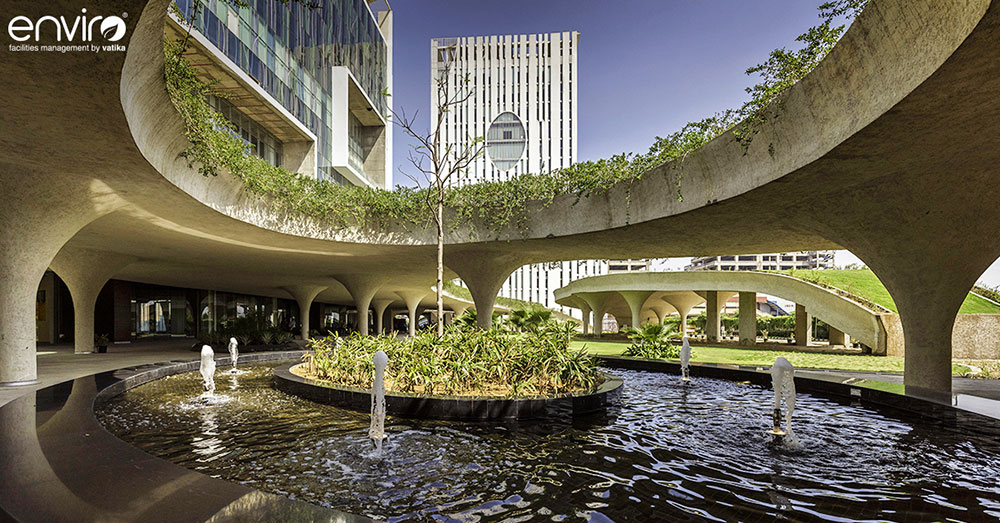In their latest report on the climate crisis, the Intergovernmental Panel on Climate Change (IPCC) has mentioned that we can still hope to escape the worst consequences of climate change, but are currently placed in a “now or never” situation where we must act immediately.
Responses to such findings as well as the changing nature of the climate crisis have been immense and proactive. These have not only come in the form of citizen demands and lifestyle changes but also, newer approaches to creating plans for more sustainable buildings.
What are sustainable or ‘green’ buildings?
Green buildings are those which try to improve or simply maintain the quality of life and harmonize within the local climate, culture, and tradition of the surrounding environment. Creating such structures has been possible thanks to changes in the approach toward design, construction and offerings.
A green building is also built with the aim to conserve resources and energy, and with the help of recycled materials. Additionally, it also looks at reducing human exposure to hazardous substances.
So, how can facility management leverage sustainable buildings in a way that the environment receives its share of returns too? Let’s have a look –
1.Leveraging Sustainability Analytics
One of the most accurate ways to get an in-depth understanding of any facilities’ performance is by conducting sustainability analytics. As a process, it gives you an overview of your building’s sustainability status.
An audit can give you a glimpse of where there’s room for improvement within your facility. An energy audit, for instance, looks at the building’s current energy usage. The report from this audit can help facility managers chart out an economical strategy for saving power and costs in the future.
Similarly, an EHS (Environment, Health, Safety) audit can help identify potential risks which might threaten the environment, safety and overall health of the tenants. A plan of action to minimise such risks can be charted out, based on the findings from the audit.
Facility managers also encounter certain challenges which are specific to green buildings. Some of these include having minimum energy efficiency standard-compliant HVAC systems and other equipment, holding a LEED certification and keeping systems 30% more efficient in comparison to other buildings. To keep a check on these, integrated facility management companies carry out facility management audits.
2.Update Your Facility Assets
The golden rule when it comes to any progress is that change is inevitable, but also necessary. Most old buildings are not carbon friendly by build or by design since they were conceptualised when concerns about the environment were not actively acknowledged. In other words, older structures are very likely to be equipped with assets that are not energy efficient. Updating one’s facility assets is perhaps one of the simplest ways to tackle this problem.
So what exactly should a facility manager look at when taking stock of what all needs a definite upgrade? To begin with, switching to modern insulation and opting for new roofing can help reduce energy loss. A switch to renewable energy sources like geothermal or solar energy can significantly boost the facility’s sustainability score. It is also important to promptly replace HVAC units, legacy boilers and windows to ensure that energy is saved.
3.Switch to Eco-Friendly Cleaning Supplies
A building itself may be sustainable by design, but our commitment to being green shouldn’t stop there. Maintaining good sanitation within shared spaces is a key responsibility of facility managers. However, most of the cleaning products used often contain unsafe ingredients, which can become an occupational hazard for cleaners and residents as well.
In this case, a simple switch to eco-friendly cleaning agents can significantly reduce the number of toxic chemicals that a building releases into the environment. Naturally, it also reduces the likelihood of residents being exposed to hazardous chemicals. The key to finding greener cleaning products is to search for those which do not use volatile organic compounds (VOC) like phosphorus and nitrogen.
4.Employ Sustainable Contractors
A sustainable attitude can manifest itself in many different ways. While your building itself may have been built green, the smallest of processes can boost its status. Employing sustainable contractors is one easy change to make. They make use of energy-efficient tools and clean products in their work and are also likely to have prior experience with low-energy assets which are most likely installed in green facilities.
Trusting contractors who actively inculcate sustainability in their work is one of the best methods of providing mindful employment while extending your larger commitment to environmental protection.
5.Adopt Planned Preventive Maintenance
Sustainable facilities require a strong system of checks and balances to be in place, with regard to the equipment being utilised. This creates the perfect conditions for employing planned preventive maintenance.
Not only does this type of maintenance keep a strict check on equipment functionality but it also identifies potential issues before they negatively impact any machinery. Thereafter, regularly scheduled repair work keeps most equipment inside buildings functioning at its best. It is essential to be more proactive when it comes to carrying out maintenance on older equipment.
Ultimately, adopting planned preventive maintenance helps boost cost-efficiency, extend equipment lifespans and, of course, boost sustainability.
Conclusion
Despite the serious nature of global warming and the resulting climate crisis, it’s rewarding to see active efforts being made to build for the future. Some changes are minor and can be implemented in a matter of days. This is how we can start preparing for tomorrow- one green building at a time.





 WhatsApp Business +91 88000 09776
WhatsApp Business +91 88000 09776
 CSC
CSC  WhatsApp Business
WhatsApp Business 